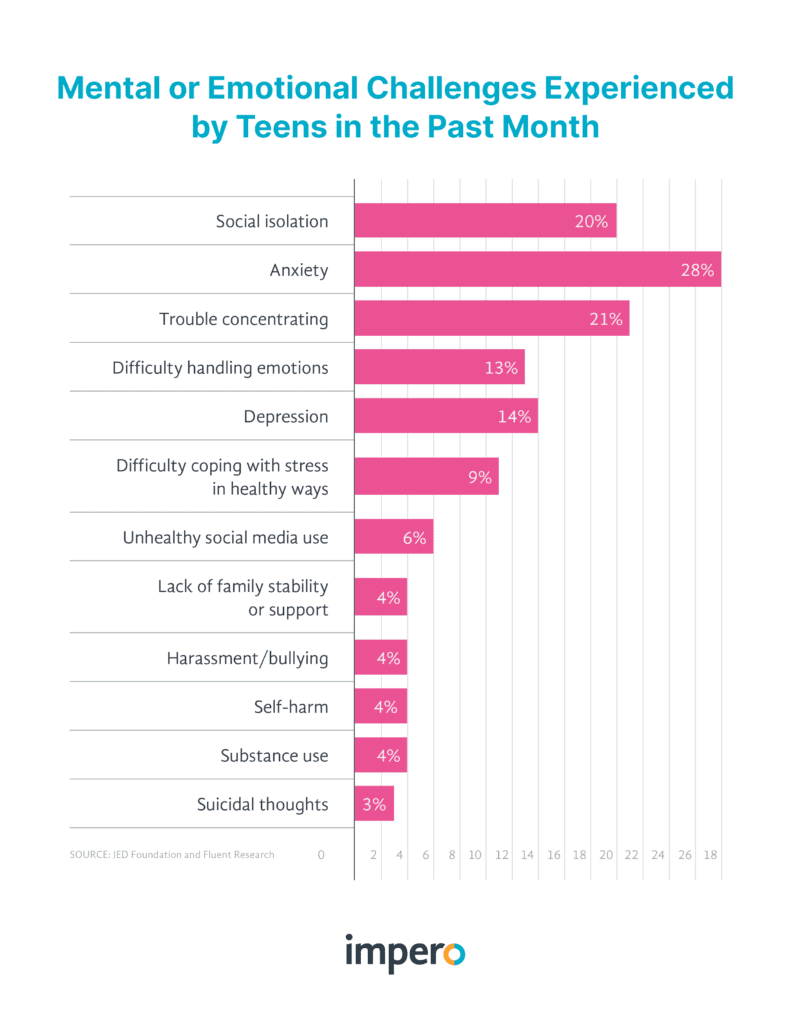As schools reopen, we are all asking the same question: are we ready?
The pandemic has flipped the ways teachers teach and students learn upside down. Schools have had to quickly adapt to continuously changing classroom environments, some teachers opened Microsoft Teams for the first time without any prior training, and remote learning became the new normal. But how did all that change affect the most vulnerable group inside the education ecosystem?
Let’s talk about students and what we learned about student mental health from the pandemic.
BMJ, a global healthcare knowledge provider, identified a steep rise in depressive symptoms among children between the ages of 7 and 12 during lockdown. Their research also found out that, on average, there was around a 70% chance that depressive symptoms worsened for any child during lockdown. Education Week also reports that there have also been increases in the levels of anxiety, stress and other more specific issues, like addictive internet behaviors, among students since the pandemic began (see Table 1). The U.S. Center for Disease Control and Prevention released data showing that from April through October 2020 there was a 24% increase in visits to the emergency department due to a mental health crisis in children between the age of 5 and 11.


We dove into social media platforms that are popular amongst students like YouTube, TikTok and Instagram to get a glimpse of what they talk about with each other. Young adults are now more vocal regarding the challenges they face, discussing topics like bullying, depression, anxiety from going back in the classroom, and sexual harassment. Furthermore, with students spending increasingly more time on social media during lockdown, cyberbullying has risen by 70%. This leads us to believe schools need a strong monitoring system to make sure pupils are protected from dangerous and triggering content online.
As schools begin to transition back to in-person learning, many are taking lessons they learned about the remote classroom along with them. Here are a few lessons we learned about student mental health from the pandemic.
Relationships are at the core of keeping students mentally healthy and active during remote learning
The connection between students and teachers is vital for providing quality education and support. This is more difficult in online learning, but can be helped by scheduling regular one-to-one calls and using tools to monitor and improve student learning and progress.
Remote learning can make engagement particularly difficult, however, when learners do not turn their cameras on during online classes, it makes the lessons miserable.
While not every student’s environment allows them to turn on their cameras, the classroom can be significantly more engaging when students can see each other’s – and their teacher’s – faces.


Meet Vladi, a student in 5th grade that has been learning mostly online since Covid-19 hit. Under normal circumstances, making homemade clay during class might be fun and messy, however, when he couldn’t share the experience with his classmates, Vladi felt lonely. He said he felt discouraged to turn on his camera as no one else was using theirs.
While some students excel during remote learning, others might fall behind
Some students prefer online learning because it provides them with a safer learning environment, ability to access classes from any location and has limited distractions. Some students might suffer from school anxiety or have sensory issues and enjoy having more control over their learning environment, making the online classroom a more desirable space. However, the majority of students do not perform well while learning remotely as they spend less time on their studies and their environment is filled with pets, siblings, parents, and other distractions.
The digital divide is growing, affecting education across the country
Students who live in poverty in the US are less likely to do well in school and on average complete fewer years of schooling. With the pandemic, the digital divide has grown, making some students’ learning experiences extremely hard as they have limited or no access to the devices and internet connection needed for online classes. According to the National Education Association, around 25% of school-aged children in the US reside in a household without internet access or devices such as a computers or a tablets. Often, a single device has to be shared by multiple people.
Schools need the right software to support their students
Software that offers benefits like classroom management, web filtering or student online safety can help schools keep students on track, limit distractions and notice warning signs of mental or behavioral health decline before they become larger issues.
Impero’s cloud-based products are carefully designed to support teachers and provide students with additional safety, no matter the learning environment. Impero well:being equips schools with powerful keyword detection tools to capture, record and identify potential warning signs of mental health issues. Impero class:room allows teachers to provide personalized support and help students from falling behind in their classes.

